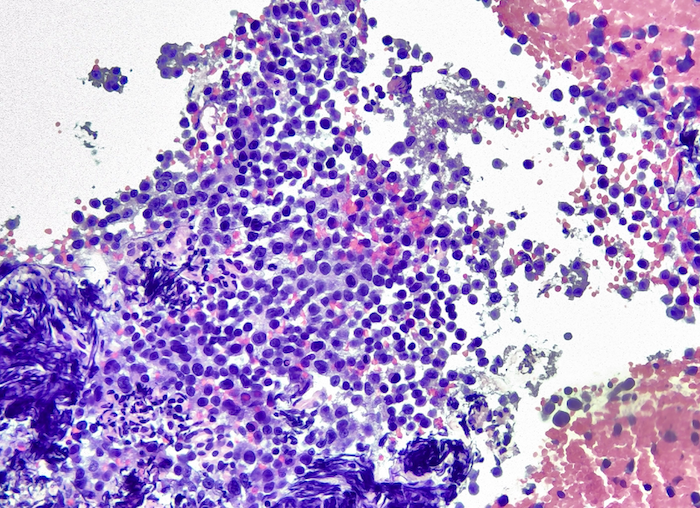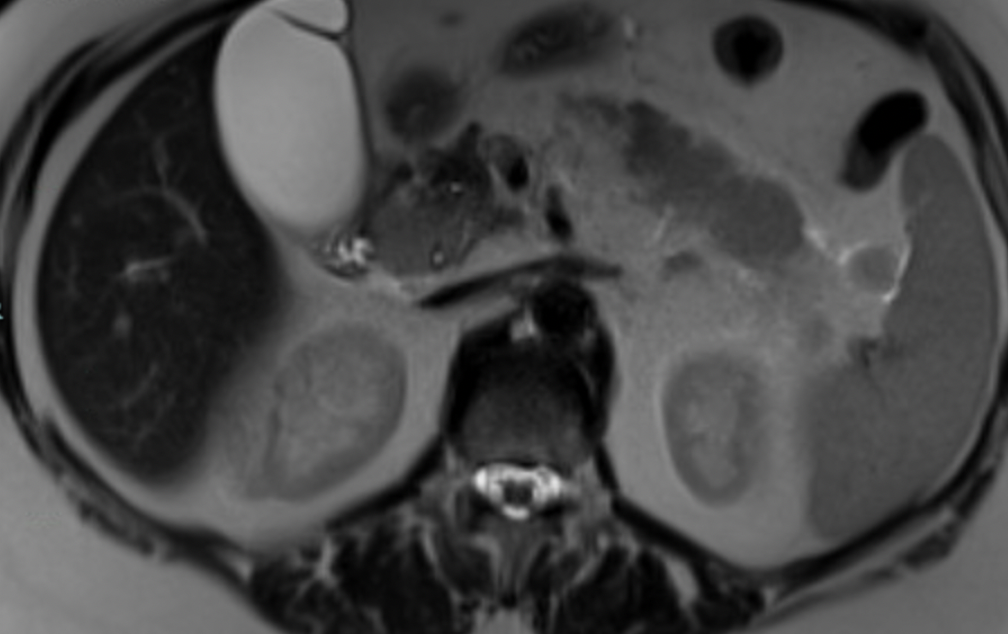Sunday Poster Session
Category: Biliary/Pancreas
P0204 - Multiple Myeloma Relapse With Pancreatic Plasmacytomas: A Case Report
Sunday, October 26, 2025
3:30 PM - 7:00 PM PDT
Location: Exhibit Hall

Davood K. Hosseini, MD
Hackensack University Medical Center
Hackensack, NJ
Presenting Author(s)
Gabrielle Sharbin, MS1, Max Edeson, BA1, Ethan Burg, MS1, Aneesh Bhave, BS1, Hanieh K. Hosseini, MS2, Katherine Panagos, MD1, Davood Karimi Hosseini, MD1, Shil Patel, DO1, Jonathan Weinberger, MD1, Hongfa Zhu, MD1, Rosario Ligresti, MD1
1Hackensack University Medical Center, Hackensack, NJ; 2Thomas J. Long School of Pharmacy, Stockton, CA
Introduction: Extramedullary plasmacytomas (EMPs) are rare tumors of neoplastic plasma cells with minimal or no bone marrow involvement. They occur in ~5% of multiple myeloma (MM) cases, often reflecting disease progression. EMPs typically affect the head, neck, or upper respiratory tract, while gastrointestinal involvement (including the pancreas) is rare, seen in ~10% of cases. Pancreatic plasmacytomas may cause obstructive jaundice or abdominal pain. We present a unique case of MM relapse with two pancreatic plasmacytomas.
Case Description/
Methods: A 59-year-old woman with a history of MGUS, MM (s/p stem cell transplant in 2024, previously in remission), cervical cancer, and hypothyroidism presented with one week of nausea, epigastric/RUQ pain, pale stools, and dark urine. Exam showed epigastric tenderness and purpura. Labs revealed hyperbilirubinemia (2.2 mg/dL), ALP 263 U/L, AST 533 U/L, ALT 1125 U/L, lipase 205 U/L, and total protein 8.5 g/dL. CT showed mild pancreatitis and gallbladder wall thickening without biliary dilation. MRI showed diffuse pancreatic enlargement with ill-defined nodular areas. EUS revealed two masses: a 3.5 cm lesion in the body and a 2.5 cm lesion in the head. Biopsy confirmed a kappa-restricted plasma cell neoplasm (CD81+, CD19-, CD20-, CD56-, CD117-, CD28-, CD27-). KCD chemotherapy (Carfilzomib, Cyclophosphamide, Dexamethasone) was initiated. Due to rising bilirubin and liver enzymes, ERCP was performed, revealing a distal CBD stricture; a stent was placed with rapid bile drainage. Three days later, the patient was re-admitted with post-ERCP pancreatitis, managed conservatively. PET showed decreased uptake in pancreatic lesions, and she transitioned to a 28-day regimen of Daratumumab, Carfilzomib, Pomalidomide, and Dexamethasone.
Discussion: Pancreatic involvement in MM is extremely rare. This case is notable for two discrete plasmacytomas, including one in the body, an uncommon site. The presentation mimicked pancreatitis and biliary obstruction, emphasizing the diagnostic challenge. EUS with biopsy was critical, despite procedural risk. Complex management including chemotherapy, ERCP, and second-line agents led to clinical improvement. This case adds to the limited literature and underscores the importance of recognizing pancreatic EMPs in relapsed MM.

Figure: Figure 1: Pancreatic biopsy, showing sheets of plasma cells (HE stain x200 magnification)

Figure: Figure 2: MRI/MRCP with and without contrast Abdomen and Pelvis
Disclosures:
Gabrielle Sharbin indicated no relevant financial relationships.
Max Edeson indicated no relevant financial relationships.
Ethan Burg indicated no relevant financial relationships.
Aneesh Bhave indicated no relevant financial relationships.
Hanieh K. Hosseini indicated no relevant financial relationships.
Katherine Panagos indicated no relevant financial relationships.
Davood Karimi Hosseini indicated no relevant financial relationships.
Shil Patel indicated no relevant financial relationships.
Jonathan Weinberger indicated no relevant financial relationships.
Hongfa Zhu indicated no relevant financial relationships.
Rosario Ligresti indicated no relevant financial relationships.
Gabrielle Sharbin, MS1, Max Edeson, BA1, Ethan Burg, MS1, Aneesh Bhave, BS1, Hanieh K. Hosseini, MS2, Katherine Panagos, MD1, Davood Karimi Hosseini, MD1, Shil Patel, DO1, Jonathan Weinberger, MD1, Hongfa Zhu, MD1, Rosario Ligresti, MD1. P0204 - Multiple Myeloma Relapse With Pancreatic Plasmacytomas: A Case Report, ACG 2025 Annual Scientific Meeting Abstracts. Phoenix, AZ: American College of Gastroenterology.
1Hackensack University Medical Center, Hackensack, NJ; 2Thomas J. Long School of Pharmacy, Stockton, CA
Introduction: Extramedullary plasmacytomas (EMPs) are rare tumors of neoplastic plasma cells with minimal or no bone marrow involvement. They occur in ~5% of multiple myeloma (MM) cases, often reflecting disease progression. EMPs typically affect the head, neck, or upper respiratory tract, while gastrointestinal involvement (including the pancreas) is rare, seen in ~10% of cases. Pancreatic plasmacytomas may cause obstructive jaundice or abdominal pain. We present a unique case of MM relapse with two pancreatic plasmacytomas.
Case Description/
Methods: A 59-year-old woman with a history of MGUS, MM (s/p stem cell transplant in 2024, previously in remission), cervical cancer, and hypothyroidism presented with one week of nausea, epigastric/RUQ pain, pale stools, and dark urine. Exam showed epigastric tenderness and purpura. Labs revealed hyperbilirubinemia (2.2 mg/dL), ALP 263 U/L, AST 533 U/L, ALT 1125 U/L, lipase 205 U/L, and total protein 8.5 g/dL. CT showed mild pancreatitis and gallbladder wall thickening without biliary dilation. MRI showed diffuse pancreatic enlargement with ill-defined nodular areas. EUS revealed two masses: a 3.5 cm lesion in the body and a 2.5 cm lesion in the head. Biopsy confirmed a kappa-restricted plasma cell neoplasm (CD81+, CD19-, CD20-, CD56-, CD117-, CD28-, CD27-). KCD chemotherapy (Carfilzomib, Cyclophosphamide, Dexamethasone) was initiated. Due to rising bilirubin and liver enzymes, ERCP was performed, revealing a distal CBD stricture; a stent was placed with rapid bile drainage. Three days later, the patient was re-admitted with post-ERCP pancreatitis, managed conservatively. PET showed decreased uptake in pancreatic lesions, and she transitioned to a 28-day regimen of Daratumumab, Carfilzomib, Pomalidomide, and Dexamethasone.
Discussion: Pancreatic involvement in MM is extremely rare. This case is notable for two discrete plasmacytomas, including one in the body, an uncommon site. The presentation mimicked pancreatitis and biliary obstruction, emphasizing the diagnostic challenge. EUS with biopsy was critical, despite procedural risk. Complex management including chemotherapy, ERCP, and second-line agents led to clinical improvement. This case adds to the limited literature and underscores the importance of recognizing pancreatic EMPs in relapsed MM.

Figure: Figure 1: Pancreatic biopsy, showing sheets of plasma cells (HE stain x200 magnification)

Figure: Figure 2: MRI/MRCP with and without contrast Abdomen and Pelvis
Disclosures:
Gabrielle Sharbin indicated no relevant financial relationships.
Max Edeson indicated no relevant financial relationships.
Ethan Burg indicated no relevant financial relationships.
Aneesh Bhave indicated no relevant financial relationships.
Hanieh K. Hosseini indicated no relevant financial relationships.
Katherine Panagos indicated no relevant financial relationships.
Davood Karimi Hosseini indicated no relevant financial relationships.
Shil Patel indicated no relevant financial relationships.
Jonathan Weinberger indicated no relevant financial relationships.
Hongfa Zhu indicated no relevant financial relationships.
Rosario Ligresti indicated no relevant financial relationships.
Gabrielle Sharbin, MS1, Max Edeson, BA1, Ethan Burg, MS1, Aneesh Bhave, BS1, Hanieh K. Hosseini, MS2, Katherine Panagos, MD1, Davood Karimi Hosseini, MD1, Shil Patel, DO1, Jonathan Weinberger, MD1, Hongfa Zhu, MD1, Rosario Ligresti, MD1. P0204 - Multiple Myeloma Relapse With Pancreatic Plasmacytomas: A Case Report, ACG 2025 Annual Scientific Meeting Abstracts. Phoenix, AZ: American College of Gastroenterology.
